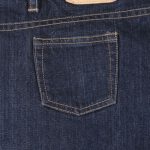Choosing jeans in the right size for your body is essential to a comfortable fit. If they are too big or too small, you may not be able to wear them. And even if you’re able to put them on, they may cause discomfort. You can avoid problems such as these by choosing jeans in the right size.
There are several different measurements in which jeans are made, however. While you might be familiar with traditional length and waist sizes, there are other measurements to consider. By familiarizing yourself with the following jean measurements, you’ll have an easier time finding the perfect size for your body.
Inseam
Inseam is a common measurement for jeans. Whether you’re shopping for stretch jeans, boot-cut jeans, cropped jeans or any other style, you should consider the inseam. What is inseam exactly, and how do you measure it?
The term “inseam” refers to the distance from the bottom of the pant legs to the bottom of the crotch. You can measure it by taking a tape measure — use a fabric tape measure for the best results — and running it from the hem at the bottom of the pant legs all the way to the bottom of the crotch. The distance between these two points is the inseam. The longer the inseam, the longer the jeans will be.
Outseam
In addition to inseam, there’s outseam. Jeans have both an inseam and outsteam. While some people assume these two measurements are the same, this isn’t the case. Inseam and outseam represent different areas of jeans.
The term “outseam” refers to the distance from the bottom of the pant legs to the top of the jeans. To measure it, run a tape measure from the top of the waistband all the way to the bottom of the pant legs.
Inseam and outseam are similar measurements that represent the length of jeans, but the outseam is always longer than the inseam. This is because outseam goes all the way to the top of the jeans where the waistband is. In comparison, inseam only goes to the bottom of the crotch. Because of this nuance, the outseam of a typical pair of jeans will be several inches longer than the inseam.
Rise
Another measurement you should know when shopping for jeans is the rise. You may come across low-rise or high-rise jeans. High-rise jeans have a longer rise measurement than their low-rise counterparts. They are both popular styles of jeans, and you can wear both of them in your daily outfits. Before investing in high-rise or low-rise jeans ,though, you should familiarize yourself with this otherwise common jean measurement.
All jeans have a rise. It represents the distance from the bottom of the crotch to the top of the jeans. Low-rise jeans may have a rise of about 9 inches, whereas high-rise jeans may have a rise of 12 inches or more. The rise is simply the distance from the bottom of the crotch to the top of the jeans.
Some people prefer low-rise jeans. Others prefer high-rise jeans. Alternatively, there are mid-rise jeans that sit around the middle of the waist when worn. The rise is simply the distance from the bottom of the crotch to the top of the jeans.

Hip
Hip is a self-explanatory jean measurement. All jeans have a hip area. It’s the area in which your hips rest when wearing them. But some jeans have a wider hip area than others.
You can measure the hip by running a tape measure from the outside of one pant leg — at the hip area — to the outside of the other hip area. The hip runs across both pant legs. It begins on the outside of one pant leg and ends on the outside of the other pant leg. The key thing to remember when measuring the hip is to stay slightly above the crotch. This is where your hip will be, so you should measure the hip of the jeans in this same area.
Thigh
You should consider the thigh when shopping for jeans. As you may have guessed, it represents the size of the thigh area. The thigh area is found directly below the hip area. Jean measurements have a hip area, followed by the crotch and then the thigh area. The crotch sits between the hip area and the thigh area.
To measure the thigh, run a tape measure across a single pant leg at the area where your thigh will be. The thigh measurement only takes into account the distance of a single pant leg. In comparison, the hip measurement takes into account the distance of both pant legs.
Waist
One of the most important jean measurements to consider is the waist. If the waist is too small for your body, you won’t be able to button or zip up the jeans. If the waist is too big, the jeans may fall when worn. To avoid problems such as these, you must choose a pair of jeans in the right waist size.
The waist area is the uppermost part of a pair of jeans. To measure it, place your jeans on a flat surface, after which you can run a tape measure from one side of the waistband to the other side of the waistband.
Men’s vs Women’s Sizes
There are different sizes for men’s and women’s jeans. Men’s sizes typically represent the waist and inseam. Women’s sizes, on the other hand, may only consist of a single number. Some women’s jeans have two numbers that, like their men’s counterparts, represent the waist and inseam. But other women’s jeans only have a single number.
If you discover that a pair of women’s jeans have a single number, it’s safe to assume it represents the waist size. In the United States, women’s waist measurements for jeans and other pants use a different system than men’s waist measurements. Some women’s jeans have a 0 waist measurement, for instance. The size 0 is the standard waist measurement for women’s jeans and other pants.











